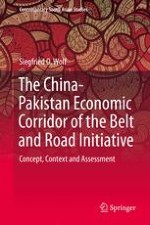2020 | OriginalPaper | Chapter
7. The GSP+ Conundrum and the CPEC’s Impact on EU-Pakistan Economic and Trade Relations
Author : Siegfried O. Wolf
Published in: The China-Pakistan Economic Corridor of the Belt and Road Initiative
Publisher: Springer International Publishing
Activate our intelligent search to find suitable subject content or patents.
Select sections of text to find matching patents with Artificial Intelligence. powered by
Select sections of text to find additional relevant content using AI-assisted search. powered by
